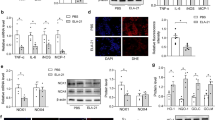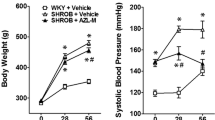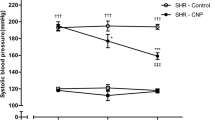Abstract.
Hepatocyte growth factor (HGF) is a unique growth factor with many protective functions. Previously, we demonstrated that HGF stimulated growth of endothelial cells without replication of vascular smooth muscle cells (VSMC) and that angiotensin (Ang) II significantly decreased local HGF production in VSMC. Moreover, we also reported that high glucose significantly decreased local vascular HGF production. Therefore, we examined effects of Ang II blockade on vascular HGF expression and endothelial injury in diabetic hypertensive rats. An angiotensin-converting enzyme inhibitor (quinapril) and an Ang II type 1 receptor antagonist (GA-0113) or vehicle was administrated to diabetic spontaneously hypertensive rats (SHR-DM), in whom diabetes was induced by streptozotocin. Endothelial function was evaluated by the vasodilator response to acetylcholine, and the expression of vascular HGF and its receptor, c-met, was examined by immunohistochemistry. Both quinapril and GA-0113 significantly improved the vasodilator response to acetylcholine (P < 0.01), while vehicle did not as compared to untreated normotensive Wistar-Kyoto rats (WKY). We next examined the effects of Ang II blockade on vascular HGF expression in SHR-DM. Importantly, the vascular HGF level was markedly decreased in SHR-DM as compared to WKY, while Ang II blockade by quinapril or GA-0113 significantly increased positive staining for HGF in SHR-DM. Similarly, staining of its specific receptor, c-met, was less in the blood vessels of SHR-DM as compared to WKY. In contrast, Ang II blockade also significantly increased c-met production in SHR-DM. The present data demonstrated the improvement of endothelial dysfunction by Ang II blockade in SHR-SM, accompanied by an increase in vascular HGF and c-met.
Similar content being viewed by others
Author information
Authors and Affiliations
Additional information
Received: June 7, 2002 / Accepted: September 21, 2002
Acknowledgments We wish to thank Rie Kosai and Keiko Yamaguchi for their excellent technical assistance. This work was partially supported by grants from the Japan Health Sciences Foundation, a Grant-in-Aid from The Ministry of Public Health and Welfare, a Grant-in-Aid for the Development of Innovative Technology, a Grant-in-Aid from Japan Promotion of Science, and through Special Coordination Funds of the Ministry of Education, Culture, Sports, Science and Technology, the Japanese Government.
Correspondence to N. Tomita
Rights and permissions
About this article
Cite this article
Matsumoto, K., Morishita, R., Tomita, N. et al. Improvement of endothelial dysfunction by angiotensin II blockade accompanied by induction of vascular hepatocyte growth factor system in diabetic spontaneously hypertensive rats. Heart Vessels 18, 18–25 (2003). https://doi.org/10.1007/s003800300003
Issue Date:
DOI: https://doi.org/10.1007/s003800300003




